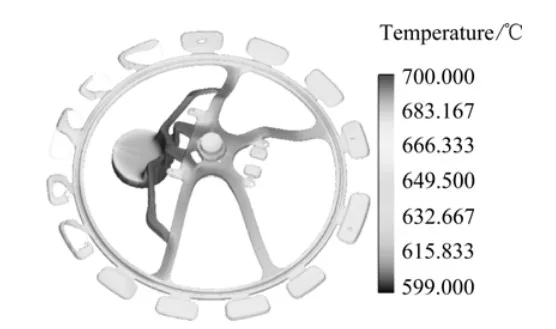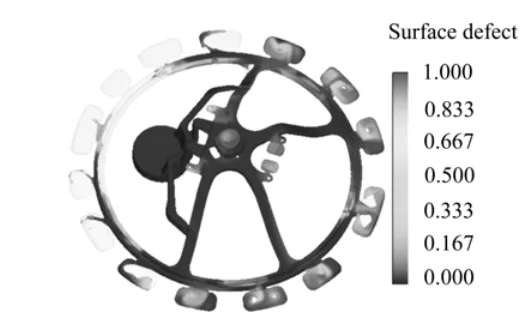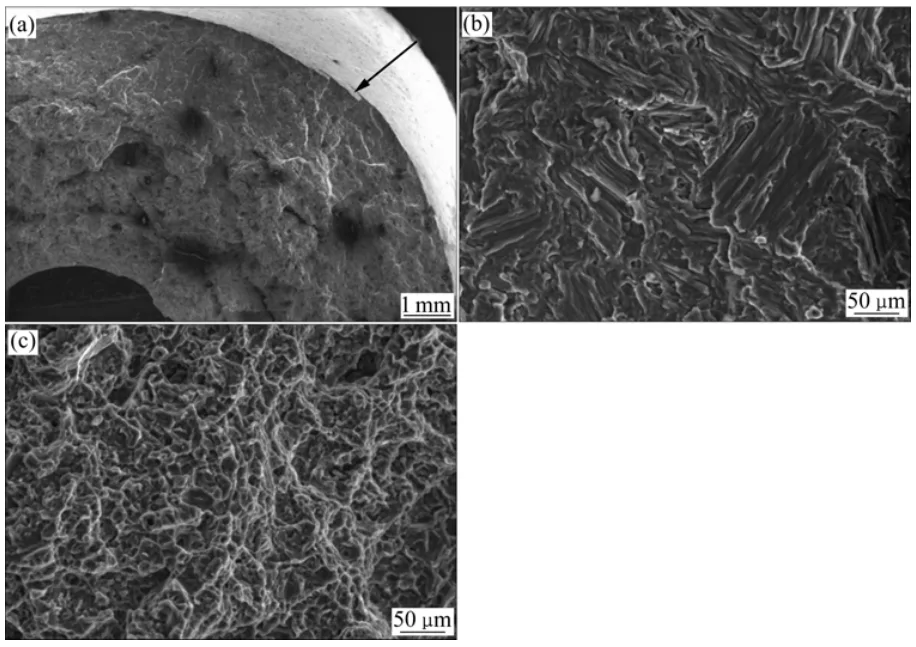This article introduces the paper "Fatigue behavior of magnesium alloy and application in auto steering wheel frame," published in Transactions of Nonferrous Metals Society of China in 2008. This paper investigates the low-cycle fatigue properties of die-cast magnesium alloys and their application in automotive steering wheel frames.
1. Overview:
- Title: Fatigue behavior of magnesium alloy and application in auto steering wheel frame
- Author: MAO Ping-li, LIU Zheng, WANG Chang-yi, GUO Quan-ying, SUN Jin, WANG Feng, LIN Li
- Publication Year: 2008
- Publishing Journal/Academic Society: Transactions of Nonferrous Metals Society of China
- Keywords: magnesium alloy; low cycle fatigue behavior; magnesium steering wheel frame

2. Research Background:
- Social/Academic Context of the Research Topic:
- Magnesium alloys are increasingly utilized in the automotive industry to manufacture lighter vehicles, aiding in meeting regulatory demands for reduced vehicle weight and lower emissions.
- Among various magnesium alloys, AZ91 and AM50 (or AM60) are prominent die-cast alloys used in producing automotive components such as steering wheel frames, transmission cases, housings, engine cradles, and pedals.
- These mechanically loaded automotive parts are frequently subjected to cyclic stresses during operation.
- Limitations of Existing Research:
- Prior research on the fatigue behavior of die-cast AZ91 and AM50 alloys has primarily concentrated on high-cycle fatigue properties.
- Limited research data is available concerning the low-cycle fatigue behavior of these alloys.
- Necessity of the Research:
- Understanding the cyclic deformation behavior, particularly low-cycle fatigue, of die-cast magnesium alloys is crucial for their reliable application in automotive components subjected to cyclic loading.
- Research indicated that the ductility of AZ91 can be significantly enhanced, and fatigue crack propagation rate reduced through treatments that produce a supersaturated solution (T4).
- The S-N curve of AZ91 showed that precipitation from supersaturated solutions (T6) offers minimal improvement in fatigue strength, although yield stress may increase.
- Mechanical properties of die-casting alloy AM60 can be improved by supersaturated solution and artificial aging treatments.
- This study focuses on the low-cyclic deformation behavior of AZ91HP in F, T4, and T6 conditions, compared to AM50HP (F).
3. Research Purpose and Research Questions:
- Research Purpose:
- To investigate the low-cycle fatigue behaviors of AZ91HP-F, AZ91HP-T6, AZ91HP-T4, and AM50HP-F magnesium alloys.
- To evaluate the potential application of AM50HP-F magnesium alloy in automotive steering wheel frames.
- Key Research Questions:
- What are the differences in low-cycle fatigue behavior among AZ91HP-F, AZ91HP-T6, AZ91HP-T4, and AM50HP-F magnesium alloys?
- How does heat treatment (F, T4, T6) affect the low-cycle fatigue life of AZ91HP alloy?
- Is AM50HP-F magnesium alloy suitable for application in automotive steering wheel frames based on its fatigue performance?
- Research Hypotheses: (Not explicitly stated in the paper, but inferred from the research direction)
- Different heat treatments will result in variations in the low-cycle fatigue behavior of AZ91HP alloy.
- AM50HP-F magnesium alloy will demonstrate suitable fatigue properties for steering wheel frame applications.
4. Research Methodology:
- Research Design:
- Comparative experimental study to assess the low-cycle fatigue behavior of different magnesium alloys and heat treatment conditions.
- Application-oriented study to evaluate the performance of AM50HP-F in a steering wheel frame.
- Data Collection Method:
- Low-cycle fatigue tests: Fully reversed total strain-controlled low-cycle fatigue tests were conducted using an MTS810 servo hydraulic testing system at room temperature in air. A triangular waveform with strain rates ranging from 7.5×10⁻³ to 1×10⁻² and five strain levels from 2.5×10⁻³ to 1.5×10⁻² were employed.
- Tensile testing: Tensile tests were performed on different parts of the magnesium steering wheel to characterize material strength.
- Bend fatigue testing: Steering wheel properties were evaluated through bend fatigue testing.
- Fatigue fracture analysis: Fatigue fracture surfaces were analyzed using Scanning Electron Microscopy (SEM).
- Die casting simulation: Flow-3D software was used to optimize die casting technological parameters for the magnesium steering wheel.
- Analysis Method:
- S-N curves: Fatigue life data was presented as plots of plastic, elastic, and total strain amplitude versus reversals to failure (2Nf).
- Basquin and Manson-Coffin laws: Fatigue life data was described using Basquin and Manson-Coffin laws, derived from lg-lg linear regression of elastic and plastic strain amplitudes.
- Fatigue crack propagation rate measurement: Fatigue crack propagation rate (da/dn) was measured and related to stress intensity factor range (ΔK).
- Statistical analysis: Comparison of fatigue lives and tensile properties across different materials and conditions.
- Fractography: SEM images were used to analyze fatigue fracture morphology and identify fracture mechanisms.
- Research Subjects and Scope:
- Materials: Die-cast magnesium alloys AZ91HP and AM50HP. Specifically, AZ91HP in three heat treatment conditions: F (as-cast), T4 (supersaturated solution), and T6 (supersaturated solution and artificial aging), and AM50HP in F condition.
- Specimen Preparation: Ingots were melted and die-cast into plates using a cold chamber die-casting machine GDK200. Specimens were cut from these plates and polished. Steering wheel frames were die-cast using optimized parameters.
- Focus: Low-cycle fatigue behavior, fatigue crack propagation, and application feasibility in automotive steering wheel frames.
5. Main Research Results:
- Key Research Results:
- Fatigue Life Comparison: The fatigue lives of AZ91HP-F and AZ91HP-T6 showed little difference in low-cycle fatigue properties.
- Crack Propagation Velocity: The crack propagation velocity of AZ91HP-T4 was lower compared to AZ91HP-F and AZ91HP-T6.
- Die Casting Optimization: Die casting technological parameters for magnesium steering wheels were optimized using Flow-3D software.
- Tensile Properties of Steering Wheel: Tensile testing of different parts of the magnesium steering wheel (wheel arm and wheel rim) showed no significant difference in ultimate tensile strength and elongation. The average ultimate tensile strength was 220 MPa, and average elongation was 5%.
- Fracture Mode: The fracture mode was brittle, and fatigue crack initiation was observed at the outside of the wheel rim.
- Steering Wheel Fatigue Performance: Fatigue testing of the AM50HP-F steering wheel frame showed an average fatigue life of 110,000 cycles, exceeding the enterprise standard of 100,000 cycles.
- Statistical/Qualitative Analysis Results:
- S-N Curves and Equations:
- For AZ91HP-F and AZ91HP-T6 (Fig.2):
- Basquin equation: Δεe/2 = 0.0132 (2Nf)^-0.155
- Manson-Coffin equation: Δεp/2 = 0.020 (2Nf)^-0.36
- For AZ91HP-T4 (Fig.3a):
- Basquin equation: Δεe/2 = 0.0150 (2Nf)^-0.186
- Manson-Coffin equation: Δεp/2 = 0.056 (2Nf)^-0.450
- For AM50HP-F (Fig.3b):
- Basquin equation: Δεe/2 = 0.0108 (2Nf)^-0.143
- Manson-Coffin equation: Δεp/2 = 0.024 (2Nf)^-0.368
- For AZ91HP-F and AZ91HP-T6 (Fig.2):
- Fatigue Crack Propagation Rate (Fig.5): Fatigue crack propagation rate of AZ91HP decreased in the order of artificial aging (T6), die casting (F), and supersaturated solution treatment (T4).
- Fracture Morphology (Fig.8): SEM images revealed that fatigue crack initiated from the outside of the wheel rim, with transgranular and cleavage features in the instantaneous fracture zone.
- S-N Curves and Equations:
- Data Interpretation:
- Heat Treatment Effects: T4 treatment in AZ91HP improved fatigue crack propagation resistance compared to F and T6 conditions.
- Material Suitability: AM50HP-F magnesium alloy demonstrated adequate fatigue life for steering wheel frame applications, meeting the required enterprise standard.
- Fatigue Failure Mechanism: Fatigue failure in the steering wheel frame initiated at the outside rim due to stress concentration under cyclic loading, exhibiting brittle fracture characteristics.
- Figure Name List:
- Fig.1 Dimensions of fatigue specimen (unit: mm)
- Fig.2 Strain amplitude vs. reversals to failure (2Nf) of AZ91HP-F and AZ91HP-T6
- Fig.3 Strain amplitude vs. reversals to failure (2Nf): (a) AZ91HP-T4; (b) AM50HP-F
- Fig.4 Monotonic and cyclic stress-strain curve
- Fig.5 Fatigue crack propagation rate at 50 Hz load frequency
- Fig.6 Fluid field simulation result (Temperature distribution in die casting)

Fig.7 Surface defect probability simulation result (in die casting) Fig.8 Fatigue fracture morphologies of AM50 HP-F steering wheel frame: (a) Full view of fracture; (b) Crack propagation zone; (c) Instantaneous fracture zoneFig.8 Fatigue fracture morphologies of AM50 HP-F steering wheel frame: (a) Full view of fracture; (b) Crack propagation zone; (c) Instantaneous fracture zone
Fig.8 Fatigue fracture morphologies of AM50 HP-F steering wheel frame: (a) Full view of fracture; (b) Crack propagation zone; (c) Instantaneous fracture zoneFig.8 Fatigue fracture morphologies of AM50 HP-F steering wheel frame: (a) Full view of fracture; (b) Crack propagation zone; (c) Instantaneous fracture zone
6. Conclusion and Discussion:
- Summary of Main Results:
- Cyclic strain hardening behavior varied among the tested magnesium alloys and heat treatments. AZ91HP-T4 exhibited the highest cyclic strain hardening, while AZ91HP-T6 showed the lowest.
- No significant difference in fatigue life was observed between die-cast AZ91HP-F and artificial aging alloy AZ91HP-T6.
- Solid solution alloy AZ91HP-T4 and die casting alloy AM50HP-F demonstrated longer fatigue lives only at very high strain amplitudes but shorter fatigue lives at low strain amplitudes compared to AZ91HP-F and -T6.
- AM50HP-F magnesium alloy was found to be suitable for manufacturing magnesium steering wheel frames, meeting the required fatigue life standard.
- Academic Significance of the Research:
- This research provides valuable low-cycle fatigue data for AZ91HP and AM50HP magnesium alloys under different heat treatment conditions.
- It contributes to a better understanding of the fatigue behavior of die-cast magnesium alloys, particularly in the low-cycle fatigue regime.
- Practical Implications:
- The study confirms the feasibility of using AM50HP-F magnesium alloy for automotive steering wheel frame applications, offering a lightweight alternative to traditional materials.
- AZ91HP-T4 is suggested as a potential alternative material, especially where improved crack propagation resistance is desired.
- The optimized die casting parameters, derived from Flow-3D simulations, can be directly applied to improve the manufacturing process of magnesium steering wheels and reduce surface defects.
- Limitations of the Research:
- The study was conducted under specific laboratory conditions (room temperature, air environment, specific strain rates and levels).
- The findings are specific to the tested alloys (AZ91HP and AM50HP) and heat treatments.
- The long-term fatigue performance and behavior under various environmental conditions (temperature, humidity, corrosion) were not investigated.
7. Future Follow-up Research:
- Directions for Follow-up Research:
- Further investigation into the fatigue behavior of magnesium alloys under various environmental conditions, including different temperatures, humidity levels, and corrosive environments, is recommended.
- Exploring other magnesium alloys and alternative heat treatments for steering wheel frame applications could lead to further performance enhancements.
- Further optimization of the die casting process, focusing on minimizing porosity and improving microstructure homogeneity, could enhance fatigue performance.
- Investigating the high-cycle fatigue behavior of AM50HP-F steering wheel frames and conducting real-world vehicle testing would provide more comprehensive validation.
- Areas Requiring Further Exploration:
- The influence of microstructure characteristics on the low-cycle fatigue behavior of these magnesium alloys.
- The effect of different loading frequencies and waveforms on fatigue life.
- The development of improved surface treatments or coatings to enhance the fatigue resistance and corrosion protection of magnesium steering wheel frames.
8. References:
- [1] FRIEDRICH H, SCHUMANN S. Research for a "new age of magnesium" in the automotive industry [J]. J Mater Proc Technol, 2001, 117: 276-281
- [2] AGHION E, BRONFIN B, ELILEZER D. The role of the magnesium industry in protecting the environment [J]. J Mater Proc Technol, 2001, 117: 381-385.
- [3] ZENNER H, RENNER F. Cyclic material behaviour of magnesium die castings and extrusions [J]. Int J Fatigue, 2002, 24: 1255-1260.
- [4] MAYER H, PAPAKYRIACOU M, ZETTL B. Influence of porosity on the fatigue limit of die cast magnesium and aluminium alloys [J]. Int J Fatigue, 2003, 25: 245-256.
- [5] HORSTEMEYER M F, YANG N, GALL K, MCDOWELL D L. High cycle fatigue of a die cast AZ91E-T4 magnesium alloy [J]. Acta Mater, 2004, 52: 1327-1336.
- [6] EISENMEIER G, HOLZWARTH B, HÖPPEL H W, MUGHRABI H. Cyclic deformation and fatigue behaviour of the magnesium alloy AZ91 [J]. Mater Sci Eng, 2001, A319-321: 578-582.
- [7] YANG Y, LIU Y B, YANG X H. High cycle fatigue properties of AZ91D die cast magnesium alloy [J]. Special Casting & Nonferrous Alloys, 2006, 26(2): 105-108
- [8] HORSTERMEYER M F, YANG N, GALL K, MCDOWELL D, FAN J, GULLETT P. High cycle fatigue mechanisms in a cast AM60B magnesium alloy [J]. Fatigue Fract Eng Mater Struct, 2002, 25: 1045-1052.
- [9] EISENMEIER G, HOLZWARTH B. Cyclic deformation and fatigue behavior of the magnesium alloy AZ91 [J]. Materials Science and Engineering, 2001, A319: 578-582.
- [10] WANG X S, LU X, WANG D H. Investigation of surface fatigue microcrack growth behavior of cast Mg-Al alloy [J]. Materials Science and Engineering, 2004, A364: 11-16.
- [11] LAMARK T T, CHEMLIK F, YURI ESTRIN Y. Cyclic deformation of a magnesium alloy investigated by the acoustic emission technique [J]. Journal of Alloys and Compounds, 2004, 378: 202-206.
- [12] LIU Z, WANG Z G, WANG Y. Cyclic deformation behavior and fatigue crack propagation in AZ91HP and AM50HP[J]. Materials Science and Technology, 2001, 17(3): 264-268.
- [13] GALL K, BIALLAS G, MAIER HJ, GULLETT I, HORSTEMEYER M F, MCDOWELL D L, FAN J H. In-situ observations of high cycle fatigue mechanism in cast AM60B magnesium in vacuum and water vapor environmental [J]. International Journal of Fatigue, 2004, 26: 59-70.
- [14] WOLF B, FLECK C, EIFLER D. Characterization of the fatigue behavior of the magnesium alloy AZ91D by means of mechanical hysteresis and temperature measurements [J]. International Journal of Fatigue, 2004, 26: 1357-1363.
- [15] LEE S G, PATEL G R, GOKHALE A M. Inverse surface macro-segregation in high-pressure die-cast AM60 magnesium alloy and its effects on fatigue behavior [J]. Scipta Materialia, 2005, 52: 1063-1068.
9. Copyright:
- This material is MAO Ping-li, LIU Zheng, WANG Chang-yi, GUO Quan-ying, SUN Jin, WANG Feng, LIN Li's paper: Based on Fatigue behavior of magnesium alloy and application in auto steering wheel frame.
- Paper Source:
This material was summarized based on the above paper, and unauthorized use for commercial purposes is prohibited.
Copyright © 2025 CASTMAN. All rights reserved.